Cloud Architecture for e-Commerce
Executive Overview
This architecture is a vendor neutral and best practices approach to describe the flows and relationships between business capabilities and architectural components for e-Commerce applications that use cloud computing infrastructure, platforms and/or services. The elements of this architecture are used to instantiate an e-Commerce system whether using private, public or hybrid cloud deployment models. Applications comprising the core components of the architecture may be delivered as a service, from on-premises or hosted.
This e-Commerce architecture explains how to support enhanced customer engagement as well as supplier and partner engagements. The customer engagement core components of Marketing, Customer Analytics and e-Commerce architecture enables enriched engagement with customers on a deeper, human level and allows them to be delighted with the right experience at the perfect moment to build lasting loyalty. The supplier and partner engagement core components of Payments, Procurement and B2BIntegration enables enhanced supplier and partner engagements that move beyond responsiveness to a synchronized, predictive value chain that mitigates risk and reveals hidden value on a global scale.
The interfaces or dependencies between these and other systems are important considerations when designing the final system architecture. In many cases some of these core systems may remain on premises, such as Warehouse Management or Point of Sale. One of the most important decisions to make when planning the e-Commerce system is deciding if on-premises components are candidates for deployment in an off-premises cloud service. Resilience and elasticity are among the considerations discussed when evaluating on-premises and “as a service” components. The intent of the evaluation is to ensure that a secure, reliable, high performance architecture is present across the e-Commerce solution. To ensure completeness a number of other components are required, such as firewalls, load balancers, databases, file repositories, content delivery networks, email and messaging.
The architecture described in this paper shows many system components that exist in a provider cloud environment. Yet it is important to understand that it is possible for some of these components to exist on-premises in the enterprise network and not in a cloud environment, particularly where there is an existing component in place which provides the required capabilities. Other considerations to make when evaluating as a service offerings, particularly for Software as a Service (SaaS) and Platform as a Service (PaaS), are the skillsets and number of personnel needed for ongoing operations and management of the component, as well as the capital expense of standing up hardware.
For the scenario where the cloud service is a PaaS offering, it is often the case that many elements of the architecture are available as part of the platform and only configuration and deployment is required. When a SaaS solution is selected the responsibilities for management are frequently reduced to configuration and user management.
The cloud deployment model affects the locations of many of the components in an e-Commerce architecture. In particular, for SaaS and public cloud deployment, the elements are instantiated in the public cloud. For private cloud deployment, the components are instantiated within the private cloud, either on-premises or within a privately managed environment made available by a cloud service provider. The likelihood that the final cloud architecture will be a hybrid IT design is high. For hybrid cloud architectures, the choice of where to locate each component, either in a public or dedicated external cloud environment or an on-premises private cloud service, is governed by security, compliance and performance considerations. The Cloud Deployment Considerations section describes options in more depth.
Holistic understanding of e-Commerce architectures is based on understanding the architectures for the mobile, web application hosting, big data and analytics and IoT capabilities that it composes. An appreciation of service provider SLAs is also helpful.
Cloud Customer Reference Architecture for e-Commerce
Figure 1 shows the elements that may be needed for any e-Commerce solution across three domains: public networks, provider clouds, and enterprise networks.
Figure 1: Elements of e-Commerce Solution
The public network domain contains commerce users and their e-Commerce channel for interaction with the enterprise. The public network also includes communication with peer clouds. The edge services handle traffic between the pubic network and the cloud. The provider cloud can host comprehensive e-Commerce capabilities— such as merchandising, location awareness, B2B2C commerce, payment processing, customer care, distributed order management, supply chain management and warehouse management. Marketing takes advantage of commerce analytics which helps with digital, cross channel, social and sentiment analytics. Using data cloud services, such as weather analytics, can help in adjusting the merchandise inventory and optimizing transportation in the provider cloud. Data services can be used to generate and aggregate insight reports from the other data cloud services, enterprise data and applications via business performance components in the provider cloud. These insights are used by users and enterprise applications and can also be used to trigger actions to be performed in the e-Commerce environment. All of this needs to be done in a secure and governed environment.
The enterprise network domain contains existing enterprise systems including enterprise applications, enterprise data stores and the enterprise user directory. Results are delivered to users and applications using transformation and connectivity components that provide secure messaging and translations to and from systems of engagement, enterprise data, and enterprise applications.
Figure 2 shows the relationships for supporting e-Commerce using cloud computing.
Figure 2: Cloud Component Relationships for e-Commerce
Components
Public network components
The public network contains elements that exist in the Internet: data sources and APIs, users, and the edge services needed to access the provider cloud or enterprise network.
e-Commerce User
An e-Commerce User is a customer who uses various channels to access the commerce solutions on the cloud provider platform or enterprise network.
Channel
Channel retailing solutions aim to provide a seamless, personalized brand experience whether the customer shops on the Web, over the phone, using a mobile device or all of the above. Not only can you create a next-generation Web channel, you can leverage the Web to improve revenues and customer service in all channels.
Key capabilities in this domain include:
• Web Site: Capabilities necessary for a direct to consumer online store. Web storefronts enhance the shopping experience with rich capabilities— from advanced faceted search and mini shopping carts, to integrated inventory availability and product comparisons. See the Cloud Customer Web Application Hosting Reference Architecture for more information. [1]
• Mobile: Supports commerce storefronts that take full advantage of mobile device browsers, touchscreens, and location based information to deliver an optimized and highly personalized mobile shopping experience. See the Cloud Customer Mobile Reference Architecture for more information. [2]
• Connected Devices: Provides the ability to have connected devices place orders for depleted products helping retailers drive an alternate channel of sales where connected devices are making buying decisions when needed. This option provides convenience to the customer and low touch sales to the retailer.
Edge Services
Services needed to allow data to flow safely from the internet into the provider cloud and into the enterprise. Edge services also support end user applications.
Key capabilities in this domain include:
• Domain Name System Server: Resolves the URL for a particular web resource to the TCP-IP address of the system or service that can deliver that resource.
• Content Delivery Networks (CDN): Supports end user applications by providing geographically distributed systems of servers deployed to minimize the response time for serving resources to geographically distributed users, ensuring that content is highly available and provided to users with minimum latency. Which servers are engaged will depend on server proximity to the user, and where the content is stored or cached.
• Firewall: Controls communication access to or from a system permitting only traffic meeting a set of policies to proceed and blocking any traffic that does not meet the policies. Firewalls can be implemented as separate dedicated hardware, or as a component in other networking hardware such as a load-balancer or router or as integral software to an operating system.
• Load Balancers: Provides distribution of network or application traffic across many resources (such as computers, processors, storage, or network links) to maximize throughput, minimize response time, increase capacity and increase reliability of applications. Load balancers can balance loads locally and globally. Load balancers should be highly available without a single point of failure. Load balancers are sometimes integrated as part of the provider cloud analytical system components like stream processing, data integration, and repositories.
Cloud Provider Components
e-Commerce Applications
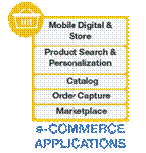 With the advent of social and mobile platforms and technologies, suppliers and retailers have started to collaborate in new ways providing capabilities to the end customer that were not possible just a few years ago. Having a retailer participate as a delivery channel for a supplier has not only provided convenience to customers by allowing direct ordering from a manufacturer, it has extended the supplier’s ability to tap into new markets and channels. For the retailer, in addition to providing convenience, it has allowed them to reach new customers and promote their brand.
With the advent of social and mobile platforms and technologies, suppliers and retailers have started to collaborate in new ways providing capabilities to the end customer that were not possible just a few years ago. Having a retailer participate as a delivery channel for a supplier has not only provided convenience to customers by allowing direct ordering from a manufacturer, it has extended the supplier’s ability to tap into new markets and channels. For the retailer, in addition to providing convenience, it has allowed them to reach new customers and promote their brand.
Key capabilities in this domain include:
• Mobile Digital & Store: Enables the convergence of physical and digital stores to provide new ways of reaching and satisfying customer requirements for shopping, delivery and personalization.
• Product Search and Personalization: Enables customers to find products more effectively. A multi-channel search solution also supports keyword search, type-ahead and search suggestions. It also extends the scope of searchable content for business users for both structured and unstructured content. The search is based around the search index which must be built before it can be used for any searches. Site administrators and business users can work with search to fine-tune search merchandising to display preferred products to shoppers. Once a set of qualified products are found, further product selection and/or display order of products can be personalized based on customer and product attributes. Personalization decision rules and scores can be applied by real time analytical engines (see Marketing and Commerce Analytics).
• Catalog: Provides a consistent view of items offered by a retailer and allows a customer to search or place an order using a mobile device, application or other IoT connected channel. The catalog offered to customers can be controlled by sales offerings, contracts or many additional rules of entitlement including customer behavior and transactional insights. The catalog offering is driven by merchants and for B2B sites, is additionally driven by individual contracts with participating external B2B entities. Catalog can include the capability to provide correct prices for the product and services offered in the catalog. The pricing and promotions functions include calculations based on product, quantities, combinations or contents of the shopping cart and, in B2B sites, contracts. In a B2B commerce scenario, it is very common to have pricing and promotions being driven off a contract with the external B2B entity participating in commerce. Catalog, pricing and promotions can also be considered a common enterprise service that enables catalog, price and promotion calculations across all participating commerce channels within the enterprise. In cases where common services are not feasible, federation of catalog, pricing and promotion data from merchandizing applications or enterprise systems to individual systems can be used.
• Order Capture: Enables the creation of shopping carts, wish lists for future purchases, shipping information, payment information, and the conversion of shopping cart to an order. Order capture also allows orders started on a mobile device to be completed in a physical store or on a web application. It also provides the capabilities of bulk order placements - orders placed from a marketplace. Integration and update of the captured order information into the customer’s existing distributed order management processes and components is supported. It also provides order information to customer’s order inquiries and integrates with customer care for providing updates on the status of the order using customer preferences. It provides the customer service rep with functionality for assisted order capture and placements.
• Marketplace: Allows customers to shop across multiple sellers. The marketplaces are analogous to physical malls which provide customers multiple shopping experiences in one convenient location. The online marketplaces typically own customer data and control the shopping experience across the sellers within the marketplace. The marketplace drives the marketing, catalog, product placements, cart management, checkout services, payment handling, order brokering and orchestration and after sales customer services. The customers place the order within the marketplace, and the marketplace brokers the orders to individual sellers selling the product. Orders can include product from multiple sellers. In many cases, the marketplace can also provide fulfillment services that can help provide a consistent fulfillment experience for the end customer.
Digital Experience
A rich, meaningful digital experience is the key to engaging customers in today’s integrated digital world.
Key capabilities in this domain include:
Content: Enables relevant personalized content to help attract and educate visitors on the benefits of the brand. Content related capabilities include content authoring tools, content management systems, content search and personalization tools (may require integration with marketing or analytical decision engines) and content servers/portals.
• Federated Search: Federated search enables customer and business users to find information about the products, catalog, product reviews and recommendations, marketing content, howto, knowledge repository, customer and internal blogs in a consistent interface across multiple domain applications. The search can be used across customer facing applications within commerce along with internal applications like customer care, order management, merchandizing and supply chain. Search has come a long way from being key-word based to now becoming cognitive and capable of answering customer queries in natural language. Technology advances in search can now allow customer and business users to interact with systems through natural conversations. Search is also becoming a key platform to enable personalization of content for end users based on contextual learning of the user’s past and current interactions with the enterprise.
• Social Engagement: Enables the provision of reviews and rankings for engaging the company and other customers in meaningful dialogs, strengthens the relationship between customers and the brand, and turns customers into brand advocates.
• Digital Messaging: Improves the creation, delivery, storage and retrieval of outbound communications, including those for marketing, new product introductions, renewal notifications, claims correspondence and documentation, and bill and payment notifications. These interactions can happen through a widespread range of media and output, including documents, email, Short Message Service (SMS) and Web pages. o Email Service: Keep customers informed of new products, clearances and special opportunities that are being offered at the store. Dynamic email allows the retailer to customize email impressions with tailored programs for each individual customer.
o Notification: Notifications help drive customer touch points by allowing notifications of store activities to be sent via email or cell phone.
Gateway
 Allows smart devices to communicate with in-store networks to search or shop and pay. This can have the same capabilities and requirements for security and scalable messaging as a mobile gateway or IoT transformation and connectivity gateway as referenced in the CSCC’s IoT reference architecture [4].
Allows smart devices to communicate with in-store networks to search or shop and pay. This can have the same capabilities and requirements for security and scalable messaging as a mobile gateway or IoT transformation and connectivity gateway as referenced in the CSCC’s IoT reference architecture [4].
Customer Care
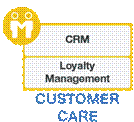 Supports customer care across the entire transaction lifecycle and all commerce channels where customer care personnel supporting the user can see behaviors of a customer in more than one channel. Whether customer care is entirely self-service or provided by customer service personnel, delivering personalized care requires access to a range of data typically residing on multiple systems (including data from warehouse, logistics, web site and PoS, purchase/account history, etc.). Online customer care is frequently offered in real time based on user behaviors such as abandoning a shopping cart or clicking back and forth between pages multiple times.
Supports customer care across the entire transaction lifecycle and all commerce channels where customer care personnel supporting the user can see behaviors of a customer in more than one channel. Whether customer care is entirely self-service or provided by customer service personnel, delivering personalized care requires access to a range of data typically residing on multiple systems (including data from warehouse, logistics, web site and PoS, purchase/account history, etc.). Online customer care is frequently offered in real time based on user behaviors such as abandoning a shopping cart or clicking back and forth between pages multiple times.
Strides in cognitive computing and natural language processing have enhanced customer care functions. Customer care can now be provided anytime, anywhere by using cognitive customer care applications that provide natural language interactions from the mobile or web application. Understanding the customer, the history of interactions, transactions and current context can all be used to offer a personalized customer care experience.
Key capabilities in this domain include:
• Customer Relationship Management (CRM): Provides broad and deep visibility into a consumer’s current and historic behavior. This is accomplished through the collection and aggregation of information from tools and sources that make up the Commerce Analytics domain.
• Loyalty Management: Allows the e-Commerce provider to build and track customer loyalty across the customer’s interactions. These systems have the capability to enable various kinds of loyalty programs tied to customer profiles. The systems provide capabilities to track loyalty either directly or through transactional feedback from the Order e-Commerce application. In addition to creating, tracking and managing loyalty programs, these systems manage various kinds of reward programs. Loyalty programs play a key role in defining the interactions between the customer and the e-Commerce provider, help to build brand awareness, and also contribute to customer retention, e.g., special offers for VIP customers, free services to platinum members, etc.
Payment
 Payment processing and payment gateway are two different functions. Payment gateways are always needed for internet commerce. If a business does not accept payments online, a payment gateway is not necessary. For internet merchants, both payment processing and payment gateways are required. Many payment processors also offer payment gateway services – selecting a single provider can simplify issue resolution if there is an outage or dispute.
Payment processing and payment gateway are two different functions. Payment gateways are always needed for internet commerce. If a business does not accept payments online, a payment gateway is not necessary. For internet merchants, both payment processing and payment gateways are required. Many payment processors also offer payment gateway services – selecting a single provider can simplify issue resolution if there is an outage or dispute.
Key capabilities in this domain include:
• Payment Processing: supports payment transactions using credit cards or electronic fund transfers which includes at least these roles:
o Merchant o Customer
o Merchant payment processing service provider o Merchant bank if different than payment processor o Customer’s bank or bank issuing credit or purchase card
Payment processing can be a for fee service - merchants are charged per transaction processed, typically a percentage of the individual purchase. The cost of the service is offset by the benefits of a faster settlement process; the merchant has more cash on hand. For customers, the benefits include security and convenience compared to mailing checks or the additional cost of money orders.
Because of the complexity of the transaction process and the stringent data security requirements and regulations it can be more cost efficient and less risky for most companies to outsource this function to a payment processor who is an expert in the relevant standards and fraud detection. The payment processor is responsible for authenticating the validity of the eCheck, credit, debit or gift card with the card issuer, sending the confirmation to the merchant’s bank and ultimately carrying out the electronic funds transfer (EFT) from customer to merchant bank to complete the payment. The payment processor covers only part of the overall Security and Fraud Detection domain.
In the U.S., payment processors initiate the EFT through the US Federal Reserve Bank’s Automated Clearing House (ACH). There is no single counterpart to this system in other parts of the world. The global standard for how companies process, store and/or transmit credit or debit card information is known as PCI DSS – Payment Card Industry Data Security Standard. This standard covers payment processors, point of sales and the interchange systems operated by the card brands.
Tokenization and end-to-end card encryption are essential to protect cardholder data and to ensure the e-Commerce providers adhere to the PCI standards. End-to-end card encryption on the card scan device is used at POS and stores, as customers can physically present/scan their cards there. Tokenization (internal or external) is used on web and mobile channels where physical card scans are not possible. The payment processor often provides credit card machines or other equipment for processing cards at the POS.
There is also an increasing adoption of newer forms of electronic payments like digital wallets like Apple-pay, Android-pay, PayPal and others. These digital wallets provide secure and convenient transactions options to the end customer and also significantly reduce the risk of fraud and associated chargebacks for e-Commerce providers. In addition, e-Commerce providers can have their own virtual currencies like virtual coins, points, loyalty rewards; each of which require special handling during payment processing.
• Payment Gateway: The Payment Gateway is the mediator between the e-Commerce transaction and the Payment Processing Service. Security requirements for purchase card transactions prohibit the direct transmission of information from the website or PoS system and the payment processor. Payment Gateways may be offered as a service by payment processing vendors or contracted from a vendor who only offers a gateway service.
Distributed Order Management
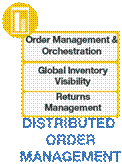 Supports inventory, order processing and order visibility. It orchestrates the workflow of orders from distribution centers/warehouses, suppliers, and thirdparty vendors for direct fulfilment and stores. Distributed Order Management can help deliver a superior customer experience when enabled to execute and coordinate order fulfillment processes across an extended supply chain network. It can provide flexible, process-based management of orders from multiple channels and enable customized fulfilment based upon user-defined business requirements. It also delivers the required visibility and event management across all fulfillment activity – allowing quick response to unexpected problems and meet customer expectations.
Supports inventory, order processing and order visibility. It orchestrates the workflow of orders from distribution centers/warehouses, suppliers, and thirdparty vendors for direct fulfilment and stores. Distributed Order Management can help deliver a superior customer experience when enabled to execute and coordinate order fulfillment processes across an extended supply chain network. It can provide flexible, process-based management of orders from multiple channels and enable customized fulfilment based upon user-defined business requirements. It also delivers the required visibility and event management across all fulfillment activity – allowing quick response to unexpected problems and meet customer expectations.
Key capabilities in this domain include:
• Order Management and Orchestration: Manages, aggregates, and monitors orders from virtually all channels usually with an intelligent sourcing engine that coordinates fulfilment across the extended enterprise. Supporting a virtual single order repository gives customers, channels, suppliers, and trading partners access to modify, cancel, track, and monitor the order lifecycle in real-time. Flexible fulfilment gives the capability to check for inventory availability, provide rule-based dynamic allocation, enable transfers when a required item is out-of-stock, select locations based on inventory availability, split orders as needed, and source or drop-ship from a channel partner.
• Global Inventory Visibility: Provides a consolidated view of inventory in warehouses, stores, and third party vendors, helping to coordinate inventory across multiple sites, enterprises and sellers, allowing managers to track inventory anywhere at both internal and external ship nodes. Global Inventory Visibility solutions provide a synchronized real-time availability view of virtually all supply and demand from multiple systems and channels, including in store, in warehouses, at distributors, at suppliers, and in transit. Global Inventory Visibility solutions utilize an intelligent sourcing engine that optimizes inventory use across the extended enterprise to provide the best available-to-promise (ATP) dates and the most efficient fulfilment options available. It also identifies shortages and allows inventory planners to resolve problems by manipulating inventory balances through the allocation of sales orders and execution of purchases or movement of inventory. Data can be shared with external systems, customers, suppliers, and partners for demand and supply management.
• Returns Management: Provides all of the capabilities that are needed to manage the entire order returns process. This capability enables the buyer and the seller to effectively track items throughout the return and repair process and automates the procedures that return items to stock. Real-time status updates from service and repair organizations also enable sellers to leverage the returns processing cycle as a source of supply. Returns management links multiple returns or repair requests to the original sales orders, providing repair lifecycle tracking to track items throughout the returns and repair processes, including exchange orders, refurbishment and repair requests, and return disposition.
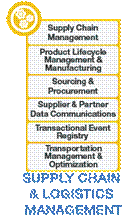
Supply Chain and Logistics Management
Enables systems to plan and manage product lifecycle, supply network, inventory including replenishments, distribution strategies, partner alliances and related analytics. Logistics management helps manage the internal logistics for purchasing, production, warehousing, and transportation within the enterprise to ensure products are available to end customers in the most efficient and cost effective way possible.
Key capabilities in this domain include:
Supply Chain Management: Enables procurement of raw goods and materials to the effective delivery of the finished product to a customer. Traditionally, the Supply Chain operated independently from Marketing, Provisioning, or Inventory Management and often had conflicting goals. With the advent of digital marketing and focus on omni-channel, the supply chain has become an integral and critical part of service and delivery to a customer. For example, weather analytics can immensely affect Supply Chain Management and should be part of its key considerations.
• Product Lifecycle Management (PLM) & Manufacturing: Supports all aspects of a product from inception to the ultimate end of life. Phases include design, engineering, manufacturing, distribution, and marketing, including people, process and technology. Efficient PLM systems assist retailers with the ever increasing complexity realized by a global marketplace. It helps retailers effectively manage complex supply chains, ever-changing customer preferences, and design challenges.
• Sourcing & Procurement: Sourcing supports the component of the procurement process that deals with supplier selection and management. With a global economy and ability to source and manufacturer products across the globe, an efficient and intelligent supply chain has become critical for the survival and success of a retailer, as well as their ability to efficiently personalize and deliver the right product at the right price. Procurement systems have advanced significantly and form the pivotal link between commerce, order management, and ultimate delivery to the end customer.
• Supplier and Partner Data Communications: Enables retailers and other commerce constituents to securely communicate business documents on shipments, inventory, invoices, purchase orders, acknowledgments, contracts, etc. Such systems should have the ability to extract, classify, encrypt/decrypt, transform and transmit data with other commerce constituents that are external or internal to a retailer. Inherent in such data communications are security, high performance, audit, verification, automation, transport layer independence, and authentication for the retailer and their business and trading partners. The use of the blockchain technology for supply chain management will dramatically reduce time delays, added costs, and human error that plague transactions today. It allows more secure and transparent tracking of all types of transactions across the supply chain.
Transactional Event Ledgers: Transactions across trading partners like suppliers, vendors, carriers, and B2B customers are driven through individual enterprise applications and the partner’s application. For example, in a vendor shipping situation, a purchase requisition is sent to the vendor/supplier as an electronic document through various communication channels and the transaction event log is maintained in the PO management system of the sender, the broker and the receiving vendor’s sales order management system. These systems then work on their own in isolation without any good way to ensure transaction integrity across partners or their applications. There is also no easy way to find the transactional events and logs through a trusted repository. In cases of discrepancies, this would normally mean some kind of audit/dispute between the involved parties and manual intervention to pull out records from individual systems to validate what was the correct set of events and transactions. Sometimes there is a need for intermediaries that both parties will trust - as in the case of certificate issuing authorities for digital certificates, stock exchanges for stocks, the US Federal Reserve for banking, etc. Intermediaries sometimes become a bottleneck and are not practical for many transactions within commerce. Distributed transactions and events managed through cryptotechnologies like blockchain provide a secure and intermediary free ledger and validation of transactions across parties like trading partners. Blockchain based applications are evolving rapidly to provide distributed transactional ledgers to capture transactions and transactional events across commerce applications and partners involved in commerce.
• Transportation Management & Optimization: Transportation Management provides a retailer with the ability to source, transport, and deliver goods effectively while managing customer demand across multiple modes of transportation and providers. Transportation Optimization provides the capability to capitalize on the most efficient and cost effective manner needed to deliver products and services. It provides the retailer with options allowing them to make critical business decisions around profitability or cost, while providing them the ability to maintain delivery schedules in the event of a failure within their supply chain.
Warehouse Management
This domain enables efficient management of warehouse operations. Combining a warehouse management system with a wireless network, mobile computers, radio frequency identification (RFID) technology, voice picking applications, and barcoding can help fully extend your enterprise to the mobile worker, while increasing operational efficiencies and enhancing your customer service.
In omni-channel commerce, stores are increasingly being used as fulfilment
centers to enable pickup in store, ship from store, and process returns at stores. In addition to their roles as centers to capture cash and carry sales, stores are participating extensively to enable commerce for other channels such as online, mobile, and call centers.
Key capabilities in this domain include:
• Warehouse Inventory Management: Supports systems to replenish stock, track costs of inventory, track profits, forecast inventory, forecast prices, forecast demand and more. The process interacts with systems to track orders, shipping, costs, stock, and sales and software that may be used to predict inventory status and track materials. Optimized inventory management will help keep costs in check, maintain a proper merchandise assortment, set targets, and monitor profits efficiently.
Inventory Optimization: Optimizes capital investment constraints or objectives over a large assortment of stock-keeping units (SKUs) while managing demand and supply volatility, and providing the correct products on shelves.
• Inventory: Holds the complete list of merchandising items or goods in stock – on hand, in transit, or returned.
Merchandising
Merchandising planning is involved in marketing the right merchandise or service at the right place, at the right time, in the right quantities, and at the right price with the goals of optimization of margins, gross revenue, or shelf life.
Key capabilities in this domain include:
• Assortment Management: Manages product variations and makes them available to the customer in a meaningful way. Enables customers to easily identify products based on familiar categories while shopping, helps merchants work with different customer profiles fitting their categories, and enables the merchants to make the right decisions of what product and assortments to sell in a particular channel.
• Pricing Management and Optimization: Involves ways to set and manage pricing and promotion of product and services based on pricing policies, strategies, goals and objectives. The pricing and promotion optimization allows merchants to set appropriate price points and promotions to achieve goals like increasing market-share, maintain margins and profitability, respond to competitive pressures and volatile costs, and maintain channel presence. Recent advancements allow commerce providers to enable dynamic pricing and promotions to provide personalized pricing and promotional offers to end customers. The pricing and promotion optimizers also enable the merchants to run “what-if” simulations to understand the impact of certain pricing strategies and tactics.
• Product Placement: Enables merchants to figure out where and how to display the products and services across customer channels to have maximum positive impact on sales. The product placements on the site tremendously influence sales. Merchant tools should allow merchants to do A/B testing and evaluate the impact of product placement, content selection within a site or partner channel to achieve their objectives. Statistical experimentation to carry out various schemes and approaches are being driven by cognitive systems that ease the burden of manual trial and error.
Commerce Analytics
Enables optimization of the shopper’s journey and improves the sales and revenue for the business. Various types of analytics are used to achieve this, such as digital analytics, cross channel analytics, social commerce and sentiments, and merchandise analytics. Commerce Analytics should drive the “next best action” solution delivering the most appropriate action at the right time across channels maximizing customer and business value. Personalized interactions are enabled by a comprehensive view of customers, real-time predictive analytics to anticipate customer behavior, preferences and attitudes, and cross-channel delivery of best action to address customer needs and enhance long-term business revenue.
Key capabilities in this domain include:
Digital Analytics: Enables the monitoring of customer interactions online with different web pages including the time customers stay on a specific section or product page and click-throughs for a specific web site. Digital analytics improves the customer’s web experience and directs their attention to specific products or services which they have liked in past visits. The use of digital analytics helps in rendering a dynamic offer for the customer on the web site.
• Cross Channel Analytics: Enables predictive, cognitive and prescriptive analytics across all channels in which customers engage. Predictive analytics helps to deliver targeted customer messages by using historical data as well as future predictions in specific markets and regions. Cognitive and prescriptive analytics are based on historical data to personalize each shopper interaction.
• Social Commerce & Sentiment Analytics: Enables the feeding of information about specific products or services from social media sites, such as Twitter and Facebook, into commerce analytics. For example, due to a weather pattern in certain regions, specific items may be in greater demand. Areas experiencing bad weather may need extra inventory of generators, umbrellas, and emergency food items.
• Merchandise Analytics & Optimization: Ensures that insights can be drawn from the customer’s journey and further optimization can be achieved for maintaining inventories and improving sales and revenues.
Marketing
This domain supports customer experiences from product exploration to purchase decision to transaction completion with personalized offers, content, and product presentations via a variety of communication channels including traditional, direct mail, email, as well as emerging mobile and social media.
Digital marketing along with mobile and social channels has altered traditional means for marketing and campaign management. Understanding what drives consumption and shopping behavior is now key to maintaining and growing market share.
Key capabilities in this domain include:
• Marketing Resource Management (MRM): Supports planning to determine strategic marketing channels, messages, and initiatives and the allocation of appropriate budgets and resources. Execution of marketing activities involves managing timelines and costs, as well as internal and external resources for implementing initiatives according to the marketing plan.
• Campaign Management: Enables the presentation of personalized, timely and relevant marketing messaging across multiple channels by using dynamic micro-segmentation with richer consumer data and sophisticated marketing analytics. Execution of an outbound marketing campaign involves:
o Defining and segmenting the target audience
o Defining content and offers/messages for each segment
o Sending out communications and tracking responses
o Defining measurement strategy (control groups, A/B) testing
In addition, location awareness is becoming even more critical in a retailer’s ability to reach out and personalize a campaign to its customers. By combining the use of mobile apps and also location-based services, campaigns can be personalized and their audience targeted specifically with content that is relevant and in context of the customer’s situation.
Real Time Recommendations: Supports defining customer/visitor experiences in interactive digital channels by defining rules for personalizing offer, content, and product recommendations. The Real Time Recommendation engine provides a centralized mechanism for selection and prioritization of marketing offers, content, and products across interactive digital channels. Product, content, and offer recommendations are based on the customer’s current shopping interests, search queries, wisdom of the crowd, predictive models, history of the visitor’s behavior, and data captured in the visitor’s profile.
Data Service
Provides the ability to access data and replicate and synchronize the data. Data services, such as a weather analytics service, will help in adjusting merchandise inventory and optimizing transportation. Other data services can be used to generate and aggregate the reports from the enterprise data and applications via business performance components in the provider cloud.
Business Performance
Enables describing and understanding the alerts, metrics, and key performance indicators (KPIs) an organization uses to monitor day-to-day commerce activity, keep track of progress against defined goals, and adjust offerings across commerce channels in response to market demand. To facilitate the output from multiple systems, the data is often combined in simple-to-view ‘dashboard’ formats tailored for a specific Line of Business or business role. Commerce Analytics and Data Services support highly granular and real-time visibility across overall customer activity, as well as the capability to drill down to individual transactions.
The advent of digital channels combining multiple touch points, technologies and platforms, plus the quest for optimal omni-channel retail, has complicated the landscape when it comes to accurately measuring a retailer’s business performance.
While there are many more consumer touch points and interactions to measure, retailers still rely on simple, fundamental metrics to provide an accurate view of their performance. These 5 areas are a common part of retail KPIs:
1. Number of customers in a store or traffic to their website
2. Conversion rates – of people that come into a store or visit a website, how many actually purchase
3. Average sales value of items purchased
4. The size of a shopping basket
5. Gross margin
Transformation and Connectivity
The transformation and connectivity component enables secure connections to enterprise systems with the ability to filter, aggregate, modify, or reformat data as needed. Data transformation is often required when data doesn’t fit enterprise applications.
Key capabilities in this domain include:
• Enterprise Secure Connectivity: Monitors usage and secures results as information is transferred to and from the cloud provider services domain into the enterprise network to enterprise applications and enterprise data.
• Transformations: Transform data between analytical systems and enterprise systems. Data is improved and augmented as it moves through the processing chain.
• Enterprise Data Connectivity: Enables analytics system components to connect securely to enterprise data.
• Extract Transform & Load: Helps in batch data load for digital catalog updates in B2B2C.
Enterprise Network Components
The enterprise network is where the on-premises systems and users are located.
Business User
A business user or merchant who accesses the commerce solutions on the cloud provider platform or enterprise network.
Internal Channel
Internal Channel Retailing solutions provide an interactive experience whether the customer shops in the store, over the phone with CSR, or using a web-based call center. Not only can businesses create a next-generation Web channel, they can leverage the Web to improve revenues and customer service in all channels.
Key capabilities in this domain include:
• In Store: Integrates the online channel with the store’s channel, to offer the best of both scenarios and propel overall revenue growth. Retailers are working to differentiate themselves by delivering outstanding shopping choices and services in stores. By deploying innovative pointof-sale solutions, informational kiosks, Web tablets and wireless communications, they can gain a competitive advantage.
• Call Center: Provides customer service representatives (CSRs) with a single point of access, webbased call center solution to access commerce information. It enables more informed omnichannel interactions with customers to help increase sales.
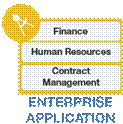 Enterprise Application
Enterprise Application
Enterprise Applications are key data sources for a commerce solution. Enterprise applications leverage cloud services and host legacy applications. Three key capabilities are described here, and the list can be expanded to include other legacy applications.
Key capabilities in this domain include:
• Finance: Supports financial systems that are an integral part of the overall e-Commerce system. Whether a standalone application or a module within an Enterprise Resource Planning application, it is connected, at minimum, to payment processing and distributed order management. Assuring timely recognition of revenue and reconciliation of accounts and inventory are among the reasons integration of this back end system is a requirement.
• Human Resources: Supports the commerce workforce including employees and contractors and all aspects of human resources management such as hiring, training, safety, retaining, payroll, benefits, etc. Effective HR management is an important part of any successful organization.
• Contract Management: Supports management of vendor and customer contracts for the enterprise. A typical contract on the “buy side” can cover negotiated terms for procurement, pricing, assortment, inventory, logistics, orders with items, quantity and times, legal terms, measurements and enforcements with external vendors and suppliers that provide product and services to the commerce provider. The typical contract on the “sell side” can cover negotiated terms for selling, pricing and promotions, assortment, inventory level, logistics terms, bulk orders, legal terms, measurements and enforcements with B2B buying organizations that purchase from the enterprise. The contract management system is also responsible for federating parts of the contract to individual domain applications for contract execution and enforcement. This includes federating approved B2B catalogs with pricing and promotions to e-Commerce sites, order management and other channel providers; sending warehousing and logistics contract portions to supply chain, warehouse management and logistics management solutions; and so on. Contract systems also have a feedback mechanism to evaluate metrics and enforcement for contracts across domain applications.
Enterprise Data
This component hosts a number of applications that deliver critical business solutions along with supporting infrastructure like data storage. Such applications are key sources of data that can be extracted and integrated with services provided by the analytics cloud solution.
Key capabilities in this domain include:
• Reference Data: Master data information about products, location, supplier, customer, store associates and employees. Master data management (MDM) provides a trusted view of critical entities typically stored and potentially duplicated in siloed applications - customers, suppliers, partners, products, materials, accounts, etc. Sometimes master data management is separated for customer data solutions and product data solutions. Master data management also helps to match if a customer is an existing or new customer.
• Transactional Data: This data describes how the business operates and includes transactional master data such as purchase orders (POs), advance shipping notices (ASN), sales orders, shipments, receipts and returns.
• Activity/Big Data: Includes customer transaction history, web activity, ratings and review, social chatter, market data, weather and events, and contextual location.
• Operation Master Data: Includes price, promotion, inventory, cost, carrier, digital content and service provider information. It also maintains the master digital product catalog.
 Enterprise User Directory
Enterprise User Directory
This component provides access to the user profiles for both the cloud users and the enterprise users. A user profile provides a login account and lists the resources (data sets, APIs, and other services) that the individual is authorized to access. The security services and edge services use this directory to drive access to the enterprise network, enterprise services, or enterprise-specific cloud provider services.
Security
Supports rigorous security needed at each step in the lifecycle of commerce applications—from raw input sources to valuable insights to sharing of data among many users and application components. Security services enable identity and access management, protection of data and applications, and actionable security intelligence across cloud and enterprise environments. It uses the catalog and user directory to understand the location and classification of the data it is protecting.
Key capabilities in this domain include:
• Identity and Access Management: Enables authentication and authorization (access management), as well as privileged identity management. Access management ensures each user is authenticated and has the right access to the environment to perform their task based on their role (that is, customers, employees, partners, supply chains, and business users).
Capabilities should include granular access control (giving users more precision for sharing data) and single sign-on facility across big data sources and repositories, data integration, data transformation, and analytics components. Privileged identity management capabilities protect, automate, and audit the use of privileged identities to ensure that the access rights are being used by the proper roles, to thwart insider threats, and to improve security across the extended enterprise, including cloud environments. This capability generally uses an enterprise user directory.
• Application and Data Protection: Services that enable and support data encryption, infrastructure and network protection, application security, data activity monitoring, and data lineage.
o Data encryption: Secures the data interchange between components to achieve confidentiality and integrity with robust encryption of data at rest as well as data in transit.
o Infrastructure and network protection: Supports the ability to monitor the traffic and communication between the different nodes (like distributed analytical processing nodes) as well as prevent man-in-the-middle, disk operating system attacks. This service also sends alerts about the presence of any bad actors or nodes in the environment.
o Application security: Ensures security is part of the development, delivery, and execution of application components, including tools to secure and scan applications as part of the application development lifecycle. Application security identifies and remedies security vulnerabilities from components that access critical data before they are deployed into production.
o Data activity monitoring: Tracks all submitted queries and maintains an audit trail for all queries run by a job. The component provides reports on sensitive data access to understand who is accessing which objects in the data sources.
o Data lineage: Traces the origin, ownership, and accuracy of the data and complements audit logs for compliance requirements.
• Security intelligence: Enables security information event management, audit and compliance support for comprehensive visibility, and actionable intelligence to detect and defend against threats through the analysis of events and logs. High-risk threats that are detected can be integrated into enterprise incident management processes. This component enables auditing capability to demonstrate that the analytics delivered by the big data platform sufficiently protects Personally Identifiable Information (PII) and delivers anonymity. It also enables automated regulatory compliance reporting. Security / fraud detection is an important part of the payment processing steps and if fraud is detected it gets reported directly to the enterprise for immediate action.
The Complete Picture
Figure 3 provides a more detailed architectural view of components, subcomponents and relationships for a cloud-based e-Commerce solution.
Figure 3: Detailed Components Diagram
Runtime Flow
A customer wants to buy new garments to attend a wedding in 4-5 weeks. He searches for a specific retailer online. The retailer offers the merchandise online and in retail stores in the mall. The retailer also maintains new designer clothes for special occasions. Figure 4 illustrates the e-Commerce flow of this typical scenario enabled by cloud computing.
Figure 4: Flow for the Digital Transformation of Retailer’s Commerce
1. The customer browses information about the needed garment using a mobile phone as the channel. The customer finds that a new design of the garment will be available in a couple of weeks. The customer registers on the website to receive information about the availability of the new design. The customer’s presence on specific mobile pages and preferences entered as part of the registration process will also be captured via the commerce analytics and marketing components.
2. After a few days, the manufacturer/retail merchant introduces the new design in their product catalog. The product launch is done through a marketing campaign on various channels including an e-Campaign. The updated e-Commerce catalogs are available for access on various channels.
3. The customer gets an email from the merchant about the new garment design. The customer opens the email and clicks on the link to go to the website to learn more about the product. Digital experience components, such as digital messaging, are used to engage the customer.
4. Based on the customer’s profile, three different variations of the product are shown on the website. When the customer appears on the site, marketing dynamic preferences can be rendered using the customer’s preferences (captured in #1 and #3).
5. The customer uses a special promotion offered to him as a preferred customer. This is achieved based on past purchases and the order capture component of e-Commerce Applications.
6. The customer places their order (payment processing occurs) using the e-Commerce
Applications. The specific customer order capture information is forwarded to distributed order management.
7. The merchant fulfills the order, ships to the customer, and sends an email to the customer with tracking information. Supply chain management is called by distributed order management to fulfill the captured order.
8. The merchant also checks the inventory in order to replenish from their contract supplier - using warehouse management.
9. The merchant sends out appropriate purchase orders, drop ship requests, and service requests, and receives shipment notices, acknowledgements, and invoices. The supply chain and logistics management components enable these steps.
10. Information obtained from social analytics (including a survey from the customer) suggests that the new variation of the product is more popular than the original. The commerce analytics sub components (Social Commerce & Sentiment Analytics) are used for this purpose.
11. Information obtained from social analytics is passed to merchandise inventory for further analytics and optimization. The merchandising gets adjusted based on feedback from commerce analytics and warehouse management.
Deployment Considerations
Cloud computing is classified based on two models: service type and deployment type. The CSCC’s Practical Guide to Cloud Computing [5] provides thorough definitions of both models and prescriptive information for choosing among the various cloud computing deployment models. The CSCC’s Practical Guide to Hybrid Cloud Computing [7] provides guidance and strategies to navigate the intricacies of hybrid planning and governance. Because e-Commerce by definition uses payment processing and/or payment gateways, the typical deployment model will be hybrid since most e-Commerce merchants do not provide their own payments processing or gateway. ISO/IEC 17788:2014 Cloud Computing Overview and Vocabulary [6] and ISO/IEC 17789:2014 Cloud Computing – Reference Architecture [7] are the basis for the CSCC’s definitions of cloud computing characteristics, roles, deployment models and service models and can also be referred to for more details. The essential characteristics of cloud computing, as described in the CSCC’s Practical Guide to Cloud Computing, are useful for focusing discussions on whether to ‘buy or build’ and which e-Commerce components to deploy where. The following section offers an overview of some of the most important considerations for deployment decisions. The suggestions of criterion for choosing a cloud adoption pattern are meant as a starting point.
Organizations should define their own decision criteria for selection of public, private or hybrid cloud components based on the specific needs of their business. Cloud technology is a fast changing space. As technologies evolve, cloud service providers (CSP) will likely offer new services and more negotiable SLAs than are now available. Key to initial deployment and successfully sustaining a viable e-Commerce solution is assurance that the governance mechanisms for keeping up to date with cloud changes and other technology and business changes are in place. These include updating the decision criteria for CSP selection and whether commerce workloads belong in public, private or hybrid clouds on a regular basis.
The E-Commerce architecture defined in Figure 2 can be applied in most industries: banking, retail, manufacturing, communications, industrial products, etc. The deployment considerations will vary depending on the maturity and investments made by organizations in existing applications, customer expectations, the goods or services offered by the merchant and the elasticity or availability requirements needed to meet peak usage for the merchant. The kinds of systems integrated and the peak usage will vary considerably between a consumer-oriented seller of toys, a B2B site for drill bits, and the online booking tool for a 24x7 car towing services provider. If no data is available to define peak usage or performance requirements – perhaps because the business is a start-up or new to e-Commerce – then collecting this information is essential to long term viability. Include analytic components upfront in the design as the data collected will provide guidance for future architectural decisions.
Customer security concerns are universal. Whether a commerce application is B2C or B2B, users need to have confidence that their personal data and payment information is held securely and that their privacy is maintained. The cost and effort to implement PCI or data security compliance frameworks will guide decisions on what cloud deployment and services model to adopt.
The first step in the deployment consideration is the definition of business capabilities that are needed by an organization. This is the time to evaluate on-premises components and current cloud services providers against typical and peak usage requirements such as ‘Black Friday’ or other seasonal increases in traffic, planned sales events, or weather related traffic. Understanding the usage scenarios will help the organization decide on the selection of “as a service” options such as PaaS and SaaS or come up with a migration or hybrid strategy based on capacity and performance forecasts. B2B sites offering repair or other services covered by delivery SLAs need to assure that the e-Commerce architecture will support these customer facing SLAs. Businesses that are new to e-Commerce in general or are expanding commerce channels to include mobile apps will need to take into consideration social media rankings that encompass goods, services, and the shopping/app experience itself. A low rating of a consumer facing app can reduce shopper traffic irrespective of the quality of what is sold. B2B merchants are not immune from social media scrutiny and criticism, and need to make the same considerations based on their users’ expectations. Once the business capabilities are agreed upon they can be mapped to the architecture components defined in Figure 2 as well as used to review existing development or other IT governance to see if modifications are needed to support a new architectural model.
The second step in the deployment consideration is the evaluation of existing investments in eCommerce. This is also the time to look closely at the responsiveness of those development practices and change management processes in place that support the e-Commerce system. Being able to modify catalogues, content, and applications rapidly is a consumer expectation for all but the smallest online merchants. Organizations may find that adopting DevOps is needed to meet customer expectations going forward. When the automation or infrastructure to adopt DevOps is not already in place, private/public cloud services can fill the void.
These new cloud capabilities then need to be integrated with existing investments in commerce running in the merchant’s data center creating a hybrid cloud.
Once there is an understanding of the known and potential peak usage scenarios and the viability of existing technology investments to support the desired future state, the third step, the selection of cloud adoption patterns for infrastructure, platform and software in the public, private or hybrid model can be made. Among the common criteria for selection of cloud adoption patterns are service level agreements (SLAs) like security, resiliency, scalability, the resources and skillsets of personnel, whether the organization budgets with a preference towards OPEX or CAPEX, and the operation and governance strategy in place. These concerns apply equally to all cloud service models: IaaS, PaaS and SaaS. Whether or not a commerce architecture component is available across cloud adoption patterns and on-premises will also dictate the choice and use of a public, private or hybrid cloud. The papers referenced in this guide provide guidance on SLAs as well as considerations for resiliency, interoperability and the like. Guidance on how to define cloud governance for public, private and hybrid architecture is also provided.
Organizations that are start-ups or have very little investments in e-Commerce may choose to use public or dedicated off-premises cloud to realize infrastructure components in support of self-managed commerce architecture components. Further, they have the option to use standardized SaaS commerce components. Organizations that have made investments in on-premises systems, such as ERPs, billing or warehouse/inventory management have a different set of opportunities for their architecture. When adding new components, they have choices such as using standardized public cloud commerce SaaS offerings or using dedicated off-premises cloud solutions to support capacity bursts. Any organization needs to make regular assessments of both their technology and development processes that support eCommerce to assure that these meet the business needs of agility and innovation. When there are needs for improvement, a decision can be made to move into either a private or public cloud component. Organizations that have made heavy investments in on-premises commerce assets, yet find their SLAs are not met by current public or dedicated cloud capabilities provided by CSP vendors would likely benefit from a hybrid cloud adoption pattern.
Once a decision has been made on a cloud pattern a final review of all system integration points is essential. Harmonizing SLAs, assuring end-to-end change notification, and updating security policies are among the areas deserving of thoughtful analysis. Integration points are also a potential area of bottlenecks. Assure that middleware, API appliances, PaaS, service busses etc. are capable of meeting peak usage. Continual transaction monitoring of integration points, from both a security and performance perspective, is highly desirable.
Summary of Key Considerations
The architect of an e-Commerce system needs to match business requirements to tools and technologies capable of satisfying customers, merchants, compliance entities and financial services providers. The ubiquity of social media as a vehicle for criticism means that an unsatisfactory experience for any one of these constituents could turn into a viral, real-time public relations problem. Cloud services such as SaaS and PaaS are typical approaches to meeting the requirements of rapid updates. Cloud elasticity and resilience assures unanticipated bursts in traffic can be supported. The following are key considerations for architects aiming for an optimal user experience across all e-Commerce channels:
• Design to meet needs for rapid change and updates in customer facing components
• Assure high performance across all components
• Take care in analyzing system interfaces and dependencies
• Assure future interoperability by choosing open standards-based components wherever possible
• Make data security a focal point across the architecture
References
ISO/IEC 17788:2014 http://www.iso.org/iso/home/store/catalogue_tc/catalogue_detail.htm?csnumber=60544
ISO/IEC 17789:2014 http://www.iso.org/iso/catalogue_detail?csnumber=60545
今天先到这儿,希望对云原生,技术领导力, 企业管理,系统架构设计与评估,团队管理, 项目管理, 产品管管,团队建设 有参考作用 , 您可能感兴趣的文章:
领导人怎样带领好团队
构建创业公司突击小团队
国际化环境下系统架构演化
微服务架构设计
视频直播平台的系统架构演化
微服务与Docker介绍
Docker与CI持续集成/CD
互联网电商购物车架构演变案例
互联网业务场景下消息队列架构
互联网高效研发团队管理演进之一
消息系统架构设计演进
互联网电商搜索架构演化之一
企业信息化与软件工程的迷思
企业项目化管理介绍
软件项目成功之要素
人际沟通风格介绍一
精益IT组织与分享式领导
学习型组织与企业
企业创新文化与等级观念
组织目标与个人目标
初创公司人才招聘与管理
人才公司环境与企业文化
企业文化、团队文化与知识共享
高效能的团队建设
项目管理沟通计划
构建高效的研发与自动化运维
某大型电商云平台实践
互联网数据库架构设计思路
IT基础架构规划方案一(网络系统规划)
餐饮行业解决方案之客户分析流程
餐饮行业解决方案之采购战略制定与实施流程
餐饮行业解决方案之业务设计流程
供应链需求调研CheckList
企业应用之性能实时度量系统演变
如有想了解更多软件设计与架构, 系统IT,企业信息化, 团队管理 资讯,请关注我的微信订阅号:
作者:Petter Liu
出处:http://www.cnblogs.com/wintersun/
本文版权归作者和博客园共有,欢迎转载,但未经作者同意必须保留此段声明,且在文章页面明显位置给出原文连接,否则保留追究法律责任的权利。
该文章也同时发布在我的独立博客中-Petter Liu Blog。
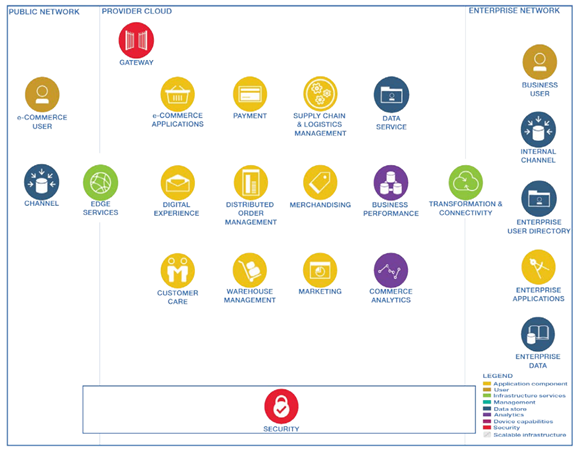
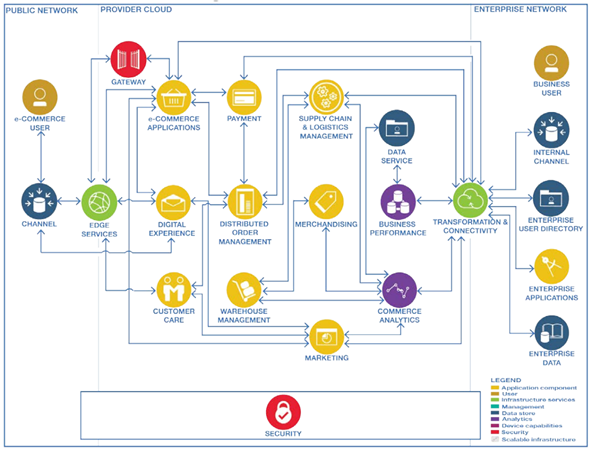
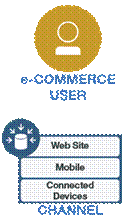

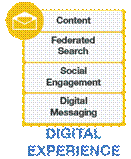
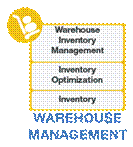
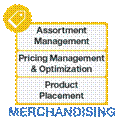
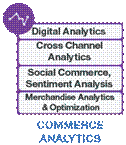







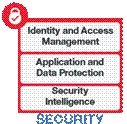

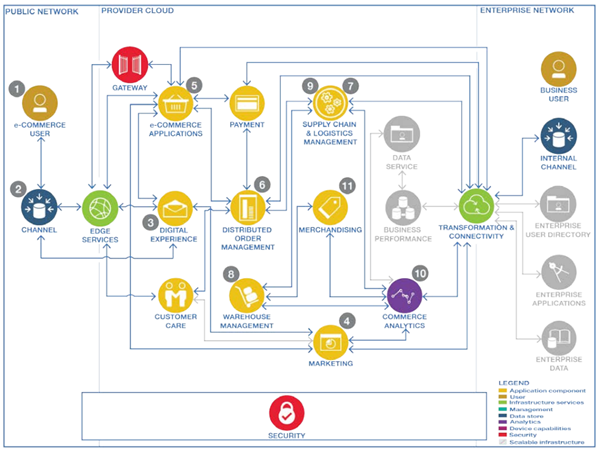
![MegadotnetMicroMsg_thumb1_thumb1_thu[2] MegadotnetMicroMsg_thumb1_thumb1_thu[2]](https://images0.cnblogs.com/blog/15172/201503/211054062506158.jpg)